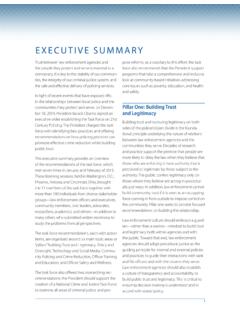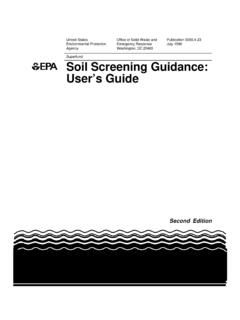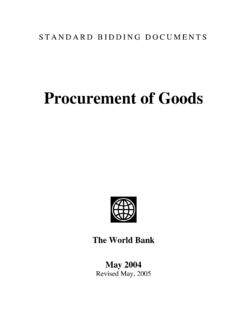Transcription of Preliminary Evaluation of the Washington State Limited ...
1 Preliminary Evaluation of the Washington State Limited license legal technician Program March 2017. Prepared by Thomas M. Clarke, National Center for State Courts, and Rebecca L. Sandefur, American Bar Foundation, with support from the Public Welfare Foundation Rebecca L. Sandefur and Thomas M. Clarke 2017. 2. Executive Summary The Washington State Supreme Court and the Washington State Bar Association created an innovative program to expand the provision of legal services. Limited Licensed legal Technicians (LLLTs). represent a new legal role that builds on the capabilities of traditional paralegals and operates without supervision by lawyers. LLLTs primarily help customers fill out legal forms and understand legal procedures. The program started with the family law practice area, but Washington State plans to expand to additional practice areas in the near future. A small number of LLLTs have been certified and are currently practicing. The Evaluation shows that the program has been appropriately designed to provide legal services to those who cannot afford a lawyer but still wish or need assistance.
2 The training program prepares LLLTs to perform their role competently while keeping within the legal scope of that role. Customers have found their legal assistance to be valuable and well worth the cost. The legitimacy of the role appears to be widely accepted in spite of its short track record. There are some questions about how best to scale up the program. The biggest current bottleneck is the required year of training with the University of Washington (UW) Law School. Washington State is actively pursing other ways to mitigate that constraint. The regulatory costs of the program are not yet close to breaking even, but scaling up the program significantly would resolve that issue. LLLTs would greatly benefit from additional training on business management and marketing, but several of the first LLLTs are successfully running a full-time LLLT practice. The example of the LLLT program in Washington State has already encouraged a second State to create a similar program. Utah is currently designing its Paralegal Practitioner program along the lines of the Washington State program.
3 Several of the recently approved program changes in Washington State were incorporated immediately into the Utah program design. The LLLT program suggests that new legal roles with costs lower than traditional lawyers are a potentially significant strategy for meeting the legal needs of many people who now are dealing with their legal problems unassisted. Creating similar programs in other states would clearly improve access to justice for a broad section of the public. 3. Table of Contents Executive Summary .. 3. Research Summary and Reccommendations .. 5. 5. Evaluation Approach .. 5. Program Appropriateness .. 6. Program Efficacy .. 8. Program Sustainability .. 9. Conclusions .. 14. Recommendations .. 14. The Bottom Line .. 15. Appendix A. Acknowledgments .. 16. 4. Research Summary and Recommendations Introduction The Washington Supreme Court's Practice of Law Board started considering the possibility of creating new legal roles almost fifteen years ago. After many years of debate and discussion, the Washington Supreme Court adopted Admission and Practice Rule (APR) 28 authorizing the creation of the Limited license legal technician (LLLT) role in June 2012.
4 APR 28 created the Limited license legal technician Board, which was tasked with developing and implementing the new license . The Washington State Bar Association (WSBA) staffs and funds the LLLT Board and regulates the LLLTs under delegated authority from the Washington Supreme Court. After several years of work to create the regulations, training, and administrative mechanisms to do so, the first LLLT candidates entered their practice-area education classes in 2014. Three further classes have begun the practice-area courses since then with many more students completing their core education requirements at the community college level. In 2015, the first LLLTs were licensed by the Washington Supreme Court. At the time research for this Evaluation was conducted, there were fifteen (15) licensed LLLTs. Since then, that number has slowly continued to A number of other states have expressed interest in the possibility of starting similar programs . Given that interest, the Public Welfare Foundation (PWF) decided to fund an independent academic Evaluation of the LLLT program.
5 Because of its more general interest in new legal roles, the PWF also funded an Evaluation of the New York City Navigator program by the same research team. Evaluation Approach Since it was likely that states would create both similar new roles and other kinds of new legal roles, the research team first created an Evaluation framework that was flexible enough to encompass a broad range of possible new legal The framework was also intended to support a variety of performance and Evaluation measures. Given different program objectives, a particular program Evaluation might utilize only a subset of the available Evaluation dimensions, but at least the approach would be roughly consistent across program types and evaluator teams. The framework identifies three broad Evaluation categories at the highest level: appropriateness, efficacy, and sustainability. Essentially, researchers want to know if a program does the right thing, does it effectively, and is capable of doing it into the future.
6 To know if the program is doing the right thing, it is necessary to see if the tasks performed by the new role align with the problems that are to be solved or the desired new services. It is also necessary to determine if the persons in the new role will be trained to perform those tasks. 1. For an excellent summary of the history, scope, and current status of the LLLT program, see Report of the Limited license legal technician Program to the Washington Supreme Court: the first three years, February 2016, Washington State Bar Association. 2. INCREASING ACCESS TO JUSTICE THROUGH EXPANDED ROLES BEYOND LAWYERS': Preliminary Evaluation AND CLASSIFICATION FRAMEWORKS, Rebecca L. Sandefur and Thomas M. Clarke, American Bar Foundation and National Center for State Courts, Chicago, IL and Williamsburg, VA, March 2015. 5. To be effective, researchers must see if the identified tasks are being performed competently by those in the new role and that, when they do so, the impacts on the targeted problems are positive and beneficial.
7 Finally, the sustainability of the program requires positive answers to three different kinds of questions. Does the regulatory regime, including training, have a stable basis? Does the business model for the new role have a stable basis? Do customers, clients, and colleagues of the new role attribute to it enough legitimacy to provide a stable clientele? At the time of this Evaluation the LLLT program was about 15 months old. The small number of certified LLLTs did not permit a rigorous statistical Evaluation . As a result, the researchers opted for a more ethnographic approach using structured interviews. Thus, this Evaluation must be considered Preliminary and provides first impressions of how the program is progressing. More definitive results must await a larger number of certified LLLTs. The researchers interviewed 13 of the 15 then certified LLLTs, mostly by They also interviewed four clients, several colleagues of various types, and representatives of both the regulatory office at the WSBA and the training schools at several State community colleges and the UW School of Law.
8 Program Appropriateness The stated objective of the LLLT program is to increase access to justice for low and moderate-income persons while protecting the public by ensuring the provision of quality legal services. This broad objective could not be pursued all at once. Instead the LLLT Board and the WSBA envisioned a more incremental approach to the new role. APR 28 was designed to have LLLTs licensed in specific practice areas, with the number of practice areas approved by the Supreme Court to grow over time. Prospective LLLTs would meet the qualifications and become licensed in each practice area separately. As practice areas were added, already licensed LLLTs could decide in which of any additional practice areas they wanted to become licensed. The scope of the LLLT's authority was Limited to be consistent with the training and testing requisite of a Limited license . For example, LLLTs were barred from representing clients in talks or negotiations with lawyers or other parties.
9 They also could not go into court hearings with their clients and assist them there. These restrictions still enabled LLLTs to provide process assistance and forms assistance. In the first practice area of family law, LLLTs can assist in these ways on a wide range of family law matters. Training on these tasks followed a three-pronged approach. First, candidates had to receive, at a minimum, an associate level degree with 45 of the credits defined in the LLLT regulations. The courses were to be completed in an ABA-approved paralegal program. Upon the completion of this core education, candidates then complete 15 credits in family law through a curriculum developed by an ABA-approved law school. Currently, the courses are offered through the UW School of Law, with Gonzaga University law professors helping to teach the courses. Concurrent with the education, candidates spend 3,000 hours working under the supervision of a licensed lawyer. In addition to these requirements, candidates must pass three exams: one at the completion of the core education (the 3.)
10 The researchers interviewed LLLTs, WSBA staff, lawyers, clients, and educators. 6. Paralegal Core Competency (PCC) Exam), an exam on the LLLT Rules of Professional Conduct, and a subject area In order to facilitate a faster ramp up of the new program, the Court approved a waiver path to the license recommended by the LLLT Board. The waiver is allowed for existing paralegals who have spent at least ten years performing substantive legal work under the supervision of an attorney and have current national certification with one of the national paralegal association. If these requirements are met, the LLLT candidate can proceed directly to the practice-area education and the requisite exams required for licensure. This waiver was initially put in place until the end of 2016, but the LLLT Board was considering an extension as this study was being done. In fact, most of the current LLLTs satisfied their core education requirement in this way, while a few of the newest LLLTs went through the complete education cycle.





